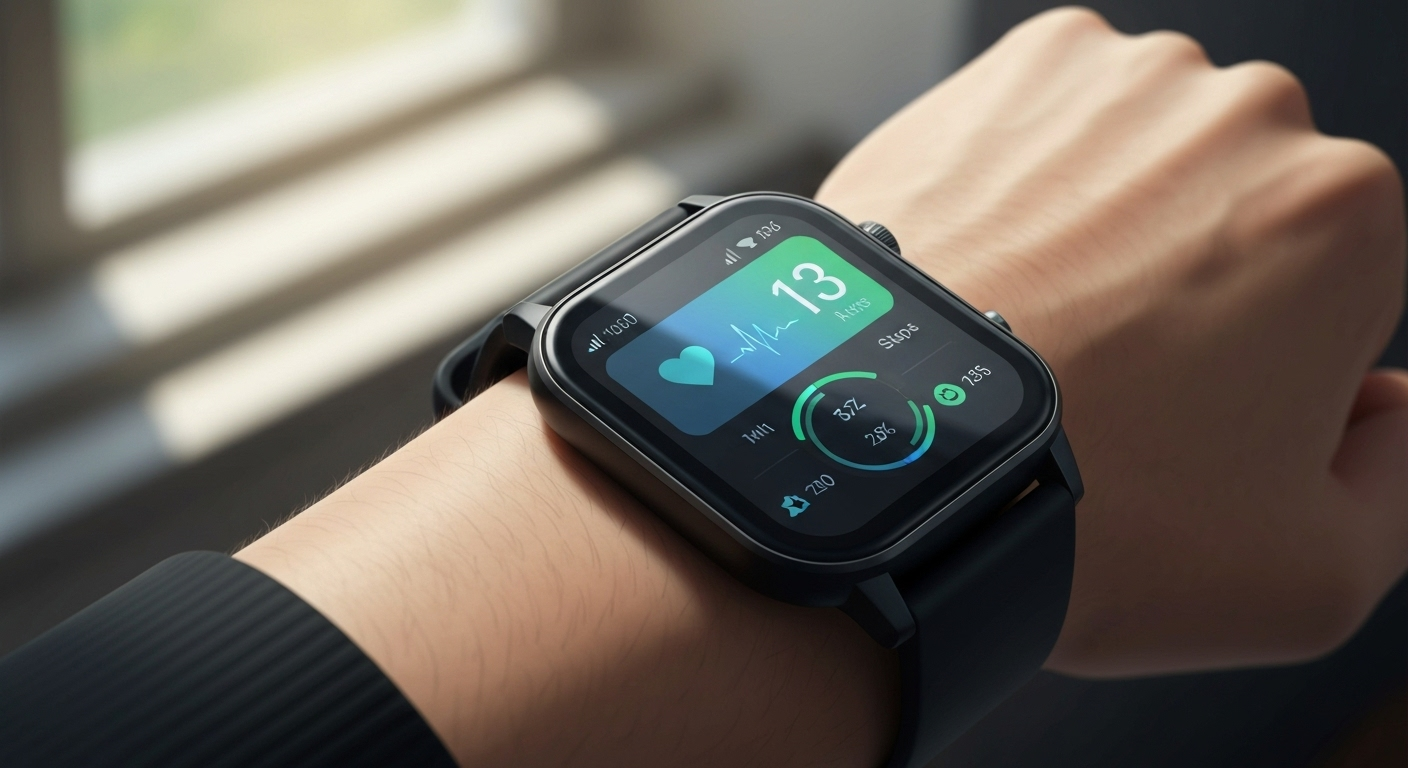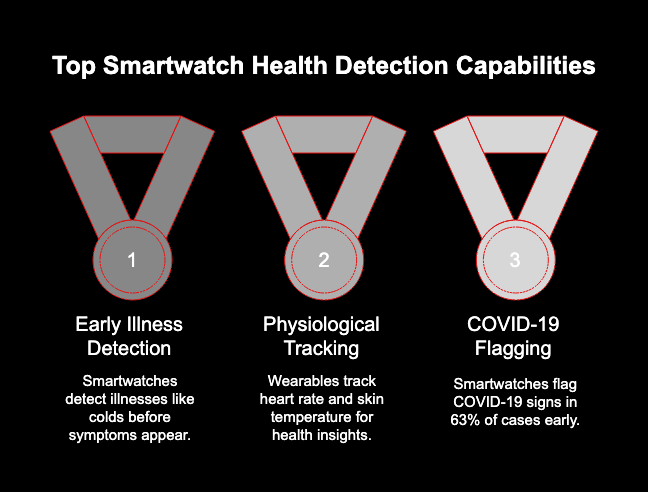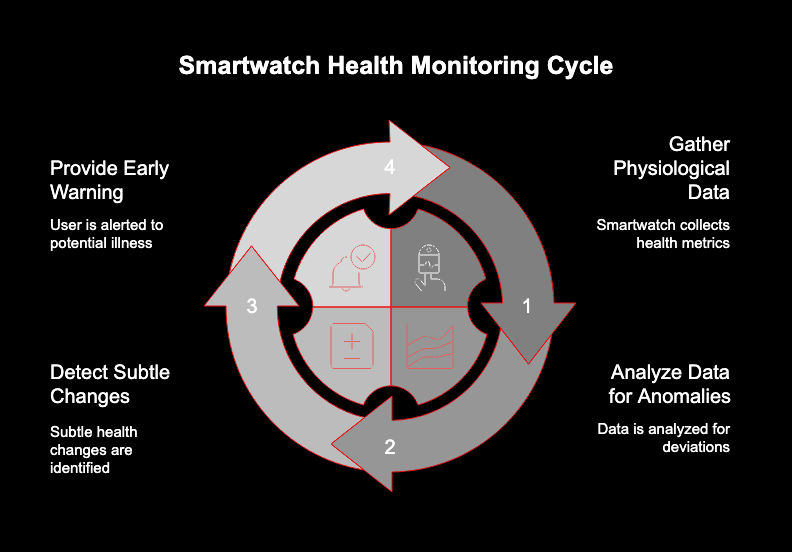
Key Highlights
- Your smartwatch may provide early detection of illnesses like the common cold before you notice symptoms.
- These wearable devices track physiological changes, such as your resting heart rate and skin temperature.
- A fitness tracker can identify deviations from your personal health baseline, signaling that your body is fighting an infection.
- Researchers at Stanford University found that smartwatches could flag signs of COVID-19 in 63% of cases before or as symptoms appeared.
- This technology acts as an early warning system, not a diagnosis, but can prompt you to rest and prevent further spread.

Introduction
Did you know the smartwatch on your wrist can do more than just track your steps or show notifications? Exciting developments in wearable technology now allow these devices to monitor your health on a deeper level. Your smartwatch could potentially give you a heads-up that you’re getting sick, sometimes days before you even feel a sniffle. This capability for early detection is transforming how we understand our bodies and manage our health, turning a simple accessory into a powerful personal wellness tool.
How Smartwatches Detect Early Signs of Illness
Your smartwatch works as a personal health detective, constantly gathering data on key physiological parameters. When your body starts to fight off an infection, it causes subtle changes that often go unnoticed. Wearable devices, however, are sensitive enough to pick up on these signals.
Research from Stanford University has shown that by analyzing shifts in metrics like heart rate variability, these devices can provide an early warning. This digital health technology essentially learns your body’s normal rhythm and alerts you when something is off. Let’s explore the specific technologies and data points that make this possible.

Understanding the Role of Wearable Technology in Health Monitoring
Wearable technology has become a constant companion for many, but its role extends far beyond fitness. These devices offer continuous health monitoring, creating a detailed picture of your body’s day-to-day functions. This constant tracking is what makes them so effective at spotting trouble early.
When your body begins to combat a virus, physiological changes occur before you experience a sore throat or cough. Your fitness tracker is designed to detect these subtle shifts. It can notice an elevated heart rate or a change in your sleep pattern, which might be the first signs that you’re about to get sick.
So, can your fitness tracker warn you if you’re about to get sick? Yes, by flagging these deviations from your normal state, it can alert you to potential health conditions. This gives you a chance to take preventive measures, like getting more rest, before the illness fully takes hold.
Interpreting Warning Signals from Your Fitness Tracker
Receiving an alert from your fitness tracker can be confusing. What should you do with this information? The key is to view these signals as an early warning rather than a diagnosis. The goal of this early detection is to make you aware of potential health anomalies.
Changes in your heart rhythms or activity levels are your body’s way of telling you something is off. A notification from your tracker empowers you to listen to your body, rest, and take preventive steps. Let’s look at how to recognize these unusual trends and understand the alerts.
Comparing Smartwatch Brands on Sickness Prediction Features
Not all smartwatches are created equal when it comes to health monitoring. Different brands, like Apple Watch and Fitbit devices, use their own brand-specific algorithms and artificial intelligence to interpret your health data. The initial Stanford University study, for example, used Fitbit devices to develop its alarm system.
While many popular smartwatches track similar core metrics, how they analyze that data for sickness prediction can vary. Some may offer more advanced features or have algorithms that are more finely tuned for early detection. We’ll explore some popular models and the algorithms that power them.
Popular Models and Their Health Capabilities
Many popular smartwatch brands now offer a suite of health-tracking features. Devices from Apple, Fitbit, and Samsung can all monitor key indicators like heart rate, sleep, and activity. Some advanced models also track blood oxygen saturation (SpO2) and skin temperature, which are valuable for illness detection.
For instance, both Apple Watch and Fitbit devices have robust heart rate sensors and detailed sleep-tracking capabilities. The latest wearable technology is increasingly focused on providing a holistic view of your health, moving beyond simple fitness tracking.
Here’s a look at some common features available on popular smartwatches:
|
Feature |
Apple Watch |
Fitbit Devices |
|---|---|---|
|
Resting Heart Rate |
Yes |
Yes |
|
Heart Rate Variability |
Yes |
Yes |
|
Blood Oxygen Saturation |
On select models |
On select models |
|
Skin Temperature |
On select models |
On select models |
|
Sleep Tracking |
Yes |
Yes |
Brand-Specific Algorithms for Early Detection
The hardware is only part of the equation; the software behind it is just as important. Each brand develops its own brand-specific algorithms to analyze the data collected by its devices. These algorithms use artificial intelligence to create a computational model of your personal health baseline.
When your data deviates from this model, the algorithm can trigger an early warning. These systems are constantly being refined as companies gather more data and improve their AI. This means the accuracy and capability of your smartwatch to predict illness are likely to improve over time.
Because each company uses a unique approach, the sensitivity and type of alerts you receive might differ between brands. However, the underlying goal is the same: to use your personal health data to provide a timely warning about potential illness, empowering you to act sooner.
Integrating Third-Party Software with Wearables
A major advantage of modern wearable devices is their ability to connect with a wide ecosystem of third-party software. This integration allows you to share your health data seamlessly with other applications that may offer specialized insights or services.
For example, you might use an app that helps manage specific health conditions by pulling data directly from your smartwatch. This creates a more dynamic and personalized health monitoring system, where your wearable acts as the central data-gathering hub.
The process of integration is usually straightforward, often requiring just a few taps within the apps to grant permission. Once connected, the software can provide a more holistic view of your health, combining your wearable data with other information you provide to offer more tailored feedback and analysis.
Conclusion
In summary, smartwatches are not just fitness trackers; they are evolving into essential health monitoring devices that can provide early warnings about potential illnesses like the common cold. By tracking vital biometrics such as heart rate variability, body temperature, and sleep patterns, these devices empower users to be proactive about their health. Understanding the signals your smartwatch sends can help you take timely action and possibly mitigate the severity of an illness. If you’re curious about how to optimize your health monitoring with wearable technology, get a free trial consultation to explore the best options for your needs!
Frequently Asked Questions
How accurate are smartwatches in predicting a cold?
The accuracy of smartwatches for early detection is promising but not perfect. Studies show they can flag signs of infection before or at symptom onset in a majority of cases. This digital health technology should be seen as an early warning tool, not a definitive diagnosis.
Can a smartwatch warn me about other illnesses before symptoms start?
Yes, the same AI-powered detection methods can provide an early warning for other health issues. By monitoring metrics like heart rhythms, blood oxygen, and sleep, wearable sensors can help flag signs of conditions like atrial fibrillation, sleep apnea, and potentially even Lyme disease before symptoms become obvious.
What changes should prompt me to seek medical advice?
You should consider seeking medical advice if you notice persistent changes like a significantly increased heart rate, a sustained change in skin temperature, or other major deviations from your normal baseline. While a smartwatch cannot diagnose health conditions, it can alert you to anomalies that warrant a professional evaluation.


